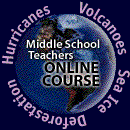![]()
![]()
![]()
Assessment
Overview: Journal Assignment & Rubric
Weeks
4-16
Goal: To demonstrate your individual growth in ESS knowledge, systems thinking, ESS classroom applications, and the cooperative learning process.
Private Space
In contrast to your team products that are public and judged for accuracy
and thoroughness against a standard, in this private space, your work
will be assessed in terms of your personal growth in knowledge, skills,
and the thoroughness of your reflection on when, how, and why that growth
occurs.
Post Your Questions
As a rule of thumb, plan to post your initial thoughts, theories, or questions;
enter information and insights as you locate them; and then reflect on
how far you’ve come. This process will not only capture the story
of your knowledge building, but it will also clearly show your growth
over the time of the course.
Post What You Know
In the beginning of each week your entries will focus on what you know,
“I know that the atmosphere is affected by a volcano….”
And what you want to know: “How is the fallout affected by the heat
released in a volcano?” At the end of each week, your entries might
read, “What I didn’t realize….” And “I figured
out….when James made that entry about the remote sensing data that…”
Organization
Through the study of the four events, your knowledge of ESS, the spheres,
the events, and cooperative learning will grow. Your journal is organized
as an archive of your thoughts in each of these areas.
This organization allows you to return to the volcano section and add an entry based on something you learn in your study of sea ice, for example. Or you can add to the section on the atmosphere, even when it is not the sphere you are studying that week.
Purpose
Think of this journal as a demonstration of your knowledge construction--a
window into what and how you are learning. But equally important, think
of this space as an archive of what you are learning--something
you can build throughout the course.
Because each of you brings different knowledge and background to the course, your entries will develop unevenly. That is, you may know a great deal about the atmosphere, but very little about the hydrosphere. Your entries under hydrosphere will be more numerous initially, but they will be overtaken by the entries in atmosphere as you increase your knowledge about that sphere. Or you may know the spheres well, but might not have integrated that knowledge into the Earth system science perspective.
Sometimes, you will want to refer to the entries made in the team discussion area. To do that, simply go to that entry, copy the URL from the location box, return to your private discussion area, create a new entry and paste the URL into it with your reason for referring to it.
As you build your archive, be thoughtful about the ‘subject’ line. Try to make it the “banner” or headline for your entry. Doing that will make the archive readable and useful at the top level. In other words, you will not have to go into each entry to see how the thinking developed. You may want to make the subject line a question, with subsequent entries to address that question.
Journal Grading
|
Weeks
Sphere
Study |
Individual Journal Assignments: Questions, theories, and prior knowledge [1 point per journal entry] 4 points total for all journal entries. Reflections on what and how you have learned [1 point per journal entry] 4 points total for all journal entries. |
|
Weeks Event
Study |
Individual Journal Assignments: Questions, theories, and prior knowledge [1 point per journal entry] 4 points total for all journal entries. Reflections on what and how you have learned [1 point per journal entry] 4 points total for all journal entries. |
|
Weeks Classroom
Application |
Individual Journal Assignments: Explain thinking behind classroom application [1 point per journal entry] 4 points total for all journal entries. Apply rubric to your classroom application [1 point per journal entry] 4 points total for all journal entries. |
|
Week Final
Project |
Individual Journal Assignments: Use the rubric to discuss your final project. [2 points per journal entry] 2 points total for all journal entries. |
![]()
Welcome
...Earth's
Spheres ...Earth
System Science ...
Use of Technology ...Science
as Inquiry ...Participation
...
Group & Team Formation ...Assessment
Overview...
Course Sections
...
Home ...Guide ...Outline ...Classroom
...
![]()

|
Sphere Study Assignment & Rubric Event Study Assignment & Rubric Classroom Application Assignment & Rubric Journal Assignment & Rubric |
Maintained by ESSC Team
Last Updated July 26, 2000
Privacy Statement and Copyright© 1997-2000 by Wheeling Jesuit University/NASA Classroom of the Future™. All rights reserved.
